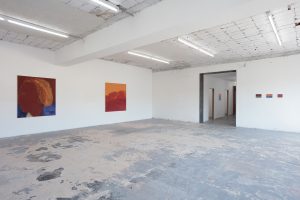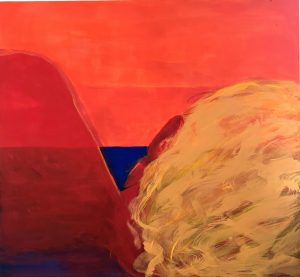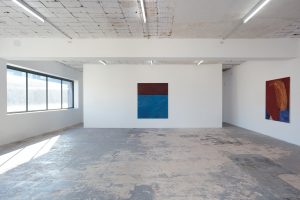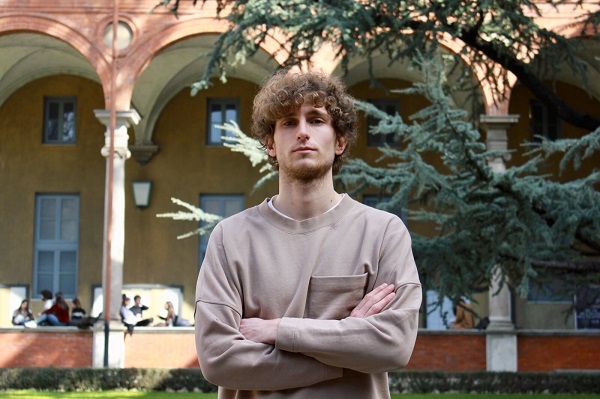Currently underway at the spaces on the second floor of ICA Milano, “Christine Safa. C’era l’acqua, ed io da sola” is the debut solo show, as well as the first exhibition in a public institution, by the French-Lebanese Christine Safa (1994).
The entire body of works was created on the occasion of the exhibition (they all date back to 2021) and stage a journey into the interiority and memory of the artist of unsettling delicacy and clarity. Safa literally goes to “undress” the many, important pieces that make up her experience to subject them, without fear, to the alien gazes of the observer. The scenarios we are faced with, painting on canvas and paintings on paper of the most varied dimensions, draw directly from the artist’s memory, influenced above all by her travels to Lebanon undertaken with her family since childhood. It is here that Safa begins to approach painting and the history of those that are an integral part of her origins, proposing an imaginary that loses any connotation of neutrality and tendencies of absolute abstraction, to propose instead landscapes, figures and individuals who are a pictorial reworking of how the artist has lived and experienced them throughout her life.
All this is accompanied by a sense of poetry exuding from the works, direct testimony – together with the shades of colour and “simplicity” of the figurative choices – of the influence of Etel Adnan, a key artistic personality for the development of Safa’s practice. The works on paper such as “La mer, par delà ton épaule” or the three canvases “Visage couché”, “Le soleil se noyant dans le mer” and “Mon visage étreint par le ciel et la mer” are a strong example of this. In general, however, from all the works on display – whose expressive power remains the same despite the most disparate dimensions and variety of mediums used – we are witnessing a continuous emergence of fragments of experience. In the space of the work, they overlap one on the other, in an indistinct amalgamation of shapes and scenarios in which the mountains become faces (“Source II”) or the human figure unites into an indistinguishable whole with real places of memory (“J’accepte d’être ici”).
As the artist explains: “[…] Perhaps we look at the things we love with the same intensity as those we have already loved, with memories of what we felt at a given moment in time, thereby giving rise to ripples of tenderness, I look at the sun drowning in the sea, as if I were watching the person I love sleeping. […] Light bathes on side of the mountain, as if it could reveal and evoke the contours of a face. And so the forehead becomes a mountain. […]”. In this sense, works such as “Il y avait l’eau, et moi toute seule II” or “La mer, par delà ton épaule” clearly translate this approach. Despite the character of extreme personalization and therefore apparent inaccessibility for anyone extraneous to the boundaries of the artist’s intimacy, an invitation to introspection with a universal meaning is perceived. As if, in the face of what are configured as gashes from which to look out on the most hidden meanders of Safa’s experience, we were magnetically led to do the same with our own person.
Paradoxically, therefore, the most intimate and fragile experience is in some respects the spokesperson for an extended invitation to inner contemplation, almost as if to break down any material and spiritual boundary between one’s “I” and “the other”. An invitation that materializes through all the works on display but, perhaps, in a more accentuated way in works such as “L’eau entière est sur moi”. In fact, two large backgrounds of colour stand out in front of the observer in an almost “Rothkan” meaning in order to define a space of immersion and cancellation towards other dimensions. Christine Safa works by layers, both in terms of technique – as explained, the starting point are colours created directly by her on which she then intervenes with pigments and marble powders, thus generating multiple layers that make up the final result – and the will to bring to light components of her own experience, freed from any form of confinement to be appreciated in all their intrinsic indecipherability. A process that allows different nuances and meanings to emerge, almost as happens with the oral passage of stories in which, each time, more or fewer light variations are witnessed, accentuating different words or passages. And it is precisely through this stratification that Safa brings her past back to life – and how she experienced it – with an absolute completeness and on a dimension that goes beyond any kind of temporal segmentation. She offers us the privilege of peeking into the most hidden corners of her person, as if to tell us, in a caressing way, how important it is to do the same to avoid forgetting that every single glimmer of light, individual or moment represents, in reality, an element of authentic essentiality for our existence.
“Nothing is as precious as this time in our life, this infinitesimal morning, this imperceptible point in the firmament of eternity, this minuscule spring that will only exist once and then never again. The cockerel sings and daylight shines. Get up my love, it’s time. It’s time: Hora! In a short while it will be too late, for this time lasts but an instant; the wind is picking up and it is now or never. Do not miss your only opportunity in the whole of eternity, do not miss your only spring morning.” (“Le je-ne-sais-quoi et le presque-rien 1”, Vladimir Jankelevitch)
Info:
Christine Safa. C’era l’acqua, ed io da sola
curated by Alberto Salvadori
18/01/2022 – 06/03/2022
ICA Milano
Via Orobia 26 – Milano
 Christine Safa, C’era l’acqua ed io da sola, installation view, Fondazione ICA Milano, 2022. Courtesy the artist and Fondazione ICA Milano, ph. Filippo Armellin
Christine Safa, C’era l’acqua ed io da sola, installation view, Fondazione ICA Milano, 2022. Courtesy the artist and Fondazione ICA Milano, ph. Filippo Armellin
 Christine Safa, La mer, par delà ton épaule, 2021, oil painting on canvas, 150 x 162 cm, courtesy the artist
Christine Safa, La mer, par delà ton épaule, 2021, oil painting on canvas, 150 x 162 cm, courtesy the artist
 Christine Safa, Source II, 2021, oil painting on canvas, 156 x 170 cm, courtesy the artist
Christine Safa, Source II, 2021, oil painting on canvas, 156 x 170 cm, courtesy the artist
 Christine Safa, C’era l’acqua ed io da sola, installation view, Fondazione ICA Milano, 2022. Courtesy the artist and Fondazione ICA Milano, ph. Filippo Armellin
Christine Safa, C’era l’acqua ed io da sola, installation view, Fondazione ICA Milano, 2022. Courtesy the artist and Fondazione ICA Milano, ph. Filippo Armellin

With a specialist degree in Economics and Management of Cultural Heritage, passionate about the field of Contemporary art, its economic dimension and, more generally, the dynamics characterizing the art market, Gabriele has gained experience over time in contexts such as contemporary art galleries, start-ups and Art Advisory. He currently works in the Art-Rite auction house as an assistant in the department of Modern and Contemporary art.






NO COMMENT